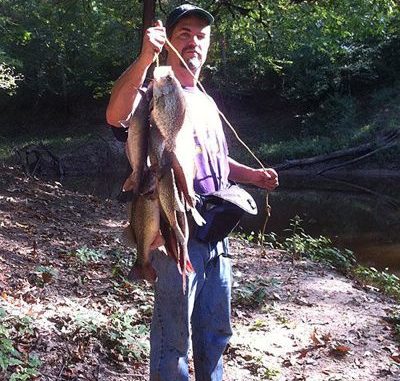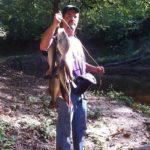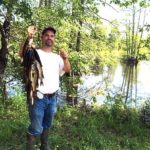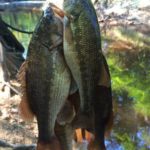
There’s a lot of untapped fishing waters in the Bayou State — and you can’t get there with a boat. Learn how this Youngsville angler steps back in time and fishes like his dad taught him.
Scott Long has a fishing secret. He and his family discovered it years ago.
Everybody who fished used to know, but apparently Long is one of only a few who retained this knowledge.
His secret?
Fishing is for fun.
It is for relaxing and slowing down. It’s for enjoying the day. It’s not just for what you catch today, either. It’s for honoring great times past and great times future.
It’s best alone or with close family. Quiet family. Crowds are for football games. Rushing is for city folks.
Fishing means solitude.
Scott Long of Youngsville is known around the country as publisher of the popular Dandydon.com LSU fan website. He set that site up for his dad and, since his passing, Long does the daily dose of Tiger sports himself.
It’s read by as many as 25,000 people a day. But as much as Long loves football, he loves fishing just as much, if not more.
And the way he loves to fish has become foreign to most today. It doesn’t involve a boat, a ramp, an outboard motor or loads of fancy tackle.
Long prefers to find out-of-the-way creeks and bayous, work his way up and down the banks to find deep holes and catch bass, bream, crappie or catfish — whatever is biting for the day.
He doesn’t mind getting wet, muddy, tired or even mosquito bit. He’s just more comfortable grabbing a single rod and reel, and a fanny pack full of H&H spinners and heading out to places most of us only drive past.
“From the time I was old enough to listen, my father told me stories of fishing a river that was very special to him, and he couldn’t wait until I was old enough to go,” Long said. “Actually, there are a lot of small rivers, bayous and the like in Louisiana, but it is not easy fishing.
“The thing is, because of the rough terrain you have to navigate to fish it — not to mention all the logs, stumps and overhanging branches that make for difficult casting — I wasn’t old enough to accompany Dad until I was about 10 or 11 years old.”
So when he finally was able to go, it meant something special.
“Nowadays, I don’t have the time to fish nearly as often as I’d like, so when I do I head out, there’s a lot of nostalgia of fishing the same places the same way my father and his father did since around the turn of the century,” Long said.
Most of those places are in Winn Parish, near his family’s old home place.
Long can’t name just one place he likes to fish this way, but he said the opportunities are plentiful.
Some of the better-known creeks and bayous in his old neck of the woods are Big Creek, Sandy Creek, Castor Creek, Whiskey Chitto, Dugdemona, Indian Creek, Bayou Kisatchie and Saline Bayou.
“Just look around where you live and you can find places like I’m talking about,” Long said. “There are opportunities statewide. Look at the maps of the area you want to fish, locate some creeks or bayous and make sure you can get access to go fishing.”
If you can’t find a spot you are sure about, you can always start at the Kistachie National Forest.
Statewide, the Louisiana Natural and Scenic Rivers System offers 51 bodies of water that can be waded or fished in small, one-man boats.
But no matter where you choose to go, there are some keys to being successful.
“First and foremost, if you have to cross someone’s land or access a spot through a hunting club, make sure you have permission,” Long said. “There are some places where you can park near a bridge and walk in to places, but don’t trespass.
“And always let someone know where you are going.”
Once you get there, you can fish for just about anything your heart desires.
“There a tons of bream, bass, catfish and occasionally crappie,” Long said. “The fish run small, for the most part, but you’ll be surprised at the size of some of the fish you catch.
“We’ve caught bass up to 4 or 5 pounds.”
Late spring and summer are the best times to fish creeks and bayous, because the water is settled and at lower stages. Muddy or high creeks are hard to fish and yield very little result, the angler said.
And you’re not necessarily looking for deep water.
“Some of these rivers are shallow enough to walk across without getting your knees wet,” Long said.
How you fish these waters can vary according to the target species.
“What I look for to catch bass are fallen logs, stumps, branches and the like — anything that creates a drift on its upstream side,” Long explained. “When I get to spots like that and the water is right (at the right level and not too muddy), I know from experience that I stand a great chance of landing one — and the anticipation is almost as exhilarating as the catch.”
The most-important part of small-river fishing is being prepared, and being able to fish with limited gear and tackle.
Long said two non-fishing equipment items are necessary.
First, a good pair of hiking boots helps, but the most-important gear to bring is a good mosquito repellent.
Typically, he wears a fanny pack strapped to his waist, which serves as his tackle box.
The only other essentials are a pocket knife and a long stringer to keep your catch on. There are no livewells in this kind of fishing.
Long loves catching bass, and his two favorite lures are white double-bladed H&H spinnerbaits and large Beetle Spins.
He also catches bream — most of them run small, but they are still tasty. Long-ears, colorful sun perch and “pumpkinseed” bream are found almost everywhere.
Because the fish are small, he uses light line and corks, a BB sinker and small hooks (from No. 6 to No. 10 work well). Longer-shanked bream hooks make it easier to remove the fish.
Scott doesn’t mind catching crappie, either, and he usually uses white or chartreuse tube jigs or occasionally live shiners.
However, live bait can be a bit difficult to get in to the fishing holes.
“There’s nothing like getting in on a school of sac-a-lait,” Long said. “That’s what I call them when I’m down here in South Louisiana. If I find myself north of Bunkie but still within the confines of the Bayou State, I call them white perch.
“The rest of the country calls them crappie.”
No matter what you call them, they are also the top fish to eat.
Fishing might be fun and relaxing, but the real reward in fishing for Long is having fried fish for supper.
He fillets them for everyone else, but he leaves his fish whole. He just seasons them, coats them in corn meal and fries them in 350-degree oil.
Two quick tips to make sure your catch is what you want when it reaches the table. First, don’t fry them too long. Second, don’t crowd the fish into the pan; they won’t cook as well.
And he still follows his dad’s advice.
“Clean the small ones first,” Long said. “That’s what Dad always said. The idea is that if you’re exhausted and have a mess of fish to clean and you begin with the large ones, by the time you get to the smallest ones you might be too tired to go on and just toss them out instead.
“We don’t waste fish.”
It’s the end of a perfect day on — or in Scott’s case — in the water.
“There’s nothing like casting your line out beside a fallen log, reeling it in slowly and feeling the thump of a Kentucky bass strike it with force,” Long said. “But, really, I think my favorite thing is just getting away — away from the hustle and bustle of modern day life.
“When I’m out there, it’s like I’ve taken a step back in time, and the stresses of day-to-day life disappear.”





